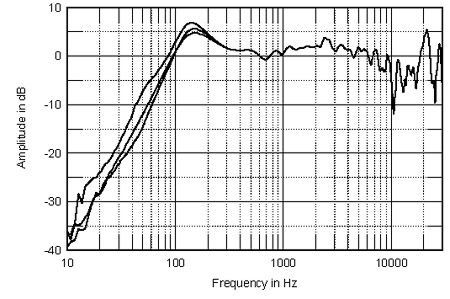And another update regarding the 310s sub with the LSR305p mkII.
I spoke too soon in my previous post. When set up correctly it's a great system.
I have it placed inbetween the speakers now on the same straight line as the speakers, not further back as suggested by JBL in the manual. I guess this is because the speakers are on stands on ear level and at a close distance to my ears as nearfield, the sub is now on an imaginary sphere distance with the speakers from my head. Sub is now also well away from any walls and I have it connected unbalanced to my DAC, set to +4dBu input level and connected with balanced cables to the 305p mkII which are set to -10dBu (according to the manual) and volume to full.
The sub volume setting is where my listening tests went wrong so far. I set it by ear to -6 before (it's a detented volume control for the sub) and this is where it was too heavy in certain ways though I felt it was the right volume (probably because of being used to the bass ported sound of the LSR305p without sub) but the right sub volume for my setup appears to be -7. (and definately not equal to the volume setting of the 305 or 308 like the manual says, I can't see how that would ever work for anybody!)
Sounds fantastic now, very open yet balanced and deep when called for. Already I couldn't live without it anymore

Not only are the extra octave below and clean bass at any volume well worth it, but perhaps even more so is the removal of the ported sound of the LSR305p without sub! It really "opens up" the sound giving more detail throughout the spectrum, not only the mids but even the highs it seems, strange how that works (no more masking?).
The removal of the 50-60Hz? port resonance of the LSR305p is of course replaced with the port resonance of the sub at I guess 30Hz or so but I find this much less bothersome now that the sub is at the right volume. The "boom" I was disturbed by before was indeed the port I found out. After stuffing it with socks the boom disappeared but the bass quality lessened (harmonic distortion below 40Hz?). But now at the right volume the boom is no longer a concern (to be clear, no longer stuffed with socks).
So recomended combo if your room can handle it! My room is about 160m3 (and keeping door open to an adjacent room about the same size), but I loaned the sub today from my little brother and he has a smaller living room with standard height ceiling and the sub doesn't work there way too many strong resonances it's a total mess sadly.
I'll be building a small studio in a corner of my room coming month (with a lot of absorption, I like it very dead from bass to treble) and will be getting my own LSR310s. Once finished I'll do some measurements of the LSR305p mkII and LSR310s and post them here.

